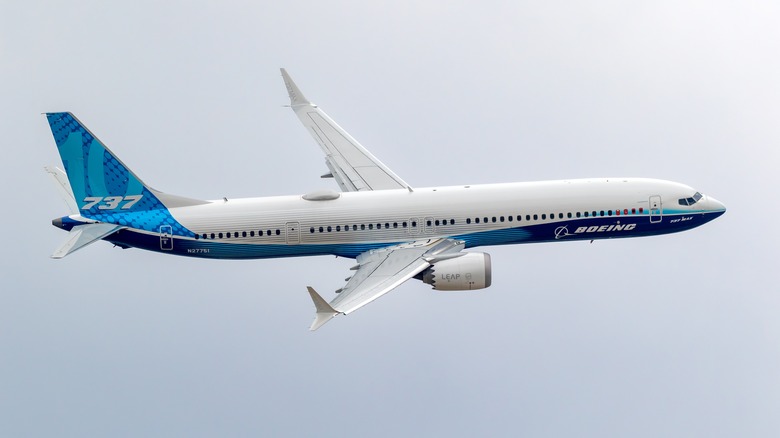What Causes An Airplane To Dutch Roll And Just How Dangerous Is It?
There are a number of aeronautical phenomena that pilots learn about in order to keep themselves and their passengers safe. Many of these, like the Dutch roll, the uninitiated are unaware of. A Dutch roll is named after a maneuver ice skaters in the Netherlands are known for performing, swaying from side to side on the blade's outer edge while also moving back and forth from right to left. Dutch rolls in the air are typically caused by high-speed winds. If one occurs, it can damage the plane's tail and fuselage.
Dutch rolls are potentially dangerous and have caused disastrous incidents midair. Commercial airplanes have a system known as the yaw dampener that can mitigate the effects of a Dutch roll. If an aircraft isn't equipped with a yaw dampener, pilots are trained to reduce the maneuver's effects, just as they're trained to both fly in and avoid extreme weather.
But exactly what is a Dutch roll? Ken Byrnes – assistant dean, associate professor of aeronautical science, and chairman of the Flight Department at Embry-Riddle Aeronautical University in Daytona Beach, Florida — told USA Today: "In Dutch roll, the aircraft experiences a rolling motion primarily driven by the design ... of the wings, while simultaneously yawing due to the adverse yaw effect caused by the sideslip angle. This coupled motion results in a dynamic instability where the aircraft oscillates in both roll and yaw directions."
Southwest Airlines got Dutch rolls in the news
While the Dutch roll doesn't happen often to commercial airliners, that doesn't mean it never happens. This May, a Boeing 737 MAX on a Southwest Airlines flight from Phoenix to Oakland, California involuntarily performed a Dutch roll. The plane managed to safely land without injury to its 175 passengers and six crewmembers, but an inspection after the flight revealed significant damage to its tail, rudder and a system that powers the rudder.
However, Newsweek reported in July that the National Transportation Safety Board's preliminary report cited bad weather on the ground for the bulk of the airplane's damage. A storm in New Orleans a few days before the plane lifted off from Phoenix had winds that reached 84 mph, and at the time Southwest's plane was parked at the city's airport. There its rudder could have slammed back and forth repeatedly until the storm finally passed. John Cox, a safety consultant and former airline pilot, told the Associated Press that there was no way a Dutch roll could have inflicted such significant damage to the aircraft.
Boeing's 737s aren't typically prone to Dutch rolls. If there's one thing to know about the 737, it's that they're built so the pilot can do nothing and the plane will naturally correct itself. Still, this was one of the luckier flights in Dutch roll history. A couple of others show how very dangerous this aerial issue can be.
A US Air Force KC-135 crashed in 2013
On May 3, 2013, three U.S. Air Force airmen of the 92nd Air Refueling Wing died in a midair explosion after the KC-135 they were aboard performed an involuntary Dutch roll. During takeoff, the aircraft experienced a system malfunction that made its nose move from side to side. The crew couldn't diagnose the issue due to both a lack of information in the inflight manual and inadequate training, leading the pilot to continue with the planned combat aerial refueling mission. When he performed a simple left turn, it increased the Dutch roll's severity.
There was no recovering the plane's stability at this point. Using the rudder as normal to make a turn exacerbated the stress on the KC-135's airframe, causing its tail section to separate from the rest of the plane, which exploded. According to the Air Force, Brig. Gen. Steve Arquiette, leader of the accident investigation board, concluded: "The crew encountered a condition that they had not realistically experienced in training, and when coupled with decisions based on their relatively low recent experience levels, were presented with an unrecognized hazardous and difficult situation to overcome."
This crash shouldn't have happened, as the plane was a KC-135R, which had new systems to prevent Dutch rolls. Investigators out of McConnell Air Force Base in Kansas attempted to re-create the flight's conditions with simulators and failed. Following this tragic event, Air Force crews received more training on recovering Dutch rolls.
Japan Airlines encountered a devastating Dutch roll
In 1978, Boeing conducted some maintenance on a 747 owned by Japan Airlines after it landed at Osaka's Itami Airport and experienced a tail strike, its tail hitting the runway. The repairs included splicing the lower half of the aft pressure bulkhead to the upper half. Seven years later, Boeing's work would be deemed faulty after it led to history's deadliest crash from a single aircraft that experienced a Dutch roll.
As the 747 reached a cruising altitude of 24,000 feet on its way from Tokyo to Osaka, its aft pressure bulkhead — the part of the plane Boeing had worked on — ruptured and depressurized the cabin. This eventually separated the Auxiliary Power Unit and part of the tail cone from the plane, causing extensive damage to the vertical stabilizer. Soon there was no control over the hydraulic systems, leading the plane into a Dutch roll coupled with phugoid motions, in which an aircraft alternates between ascending and descending, pitching up, then down. This lasted for roughly 32 minutes.
After only being in the air for over 40 minutes, JA8119 Flight 123 crashed into Mount Osutaka, northwest of Tokyo. The crash killed 520 people. Only four survived, and they had severe injuries.



